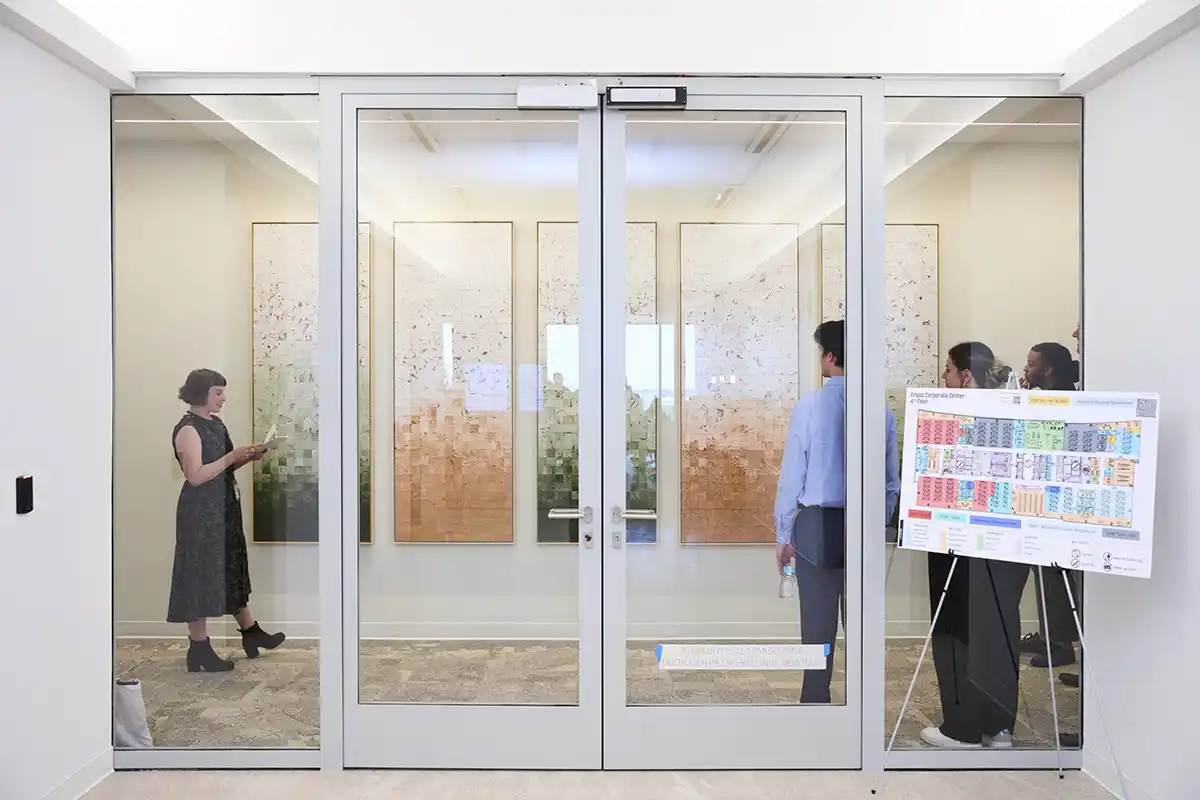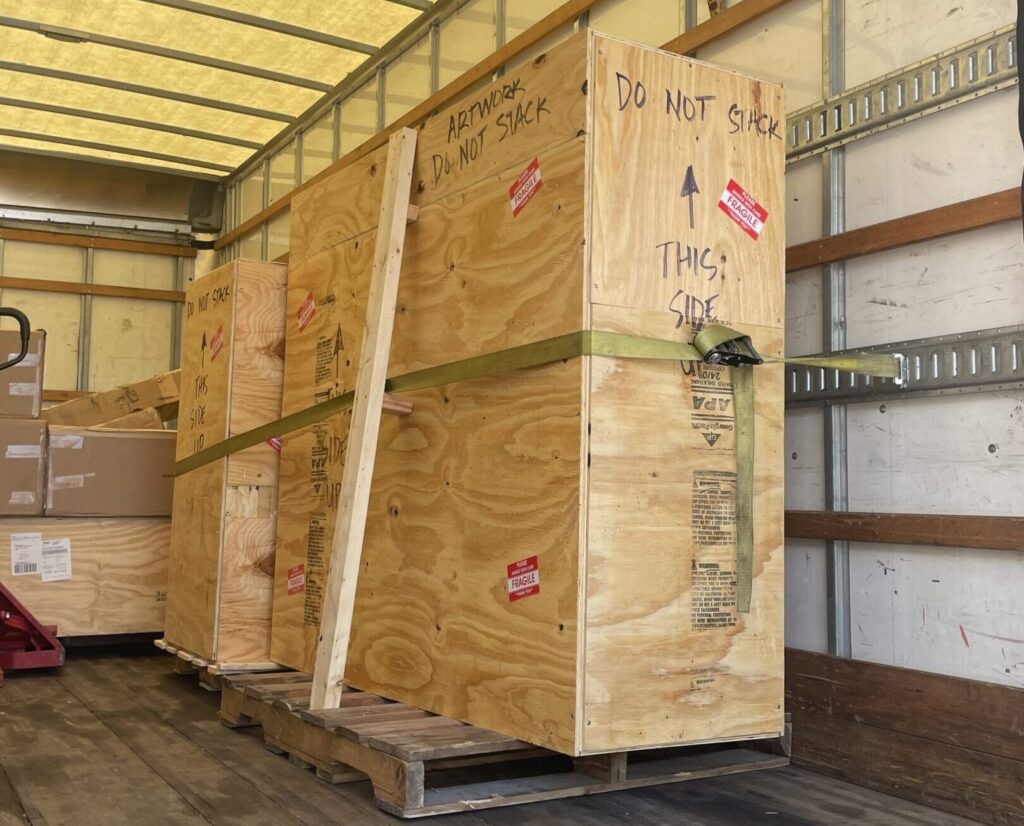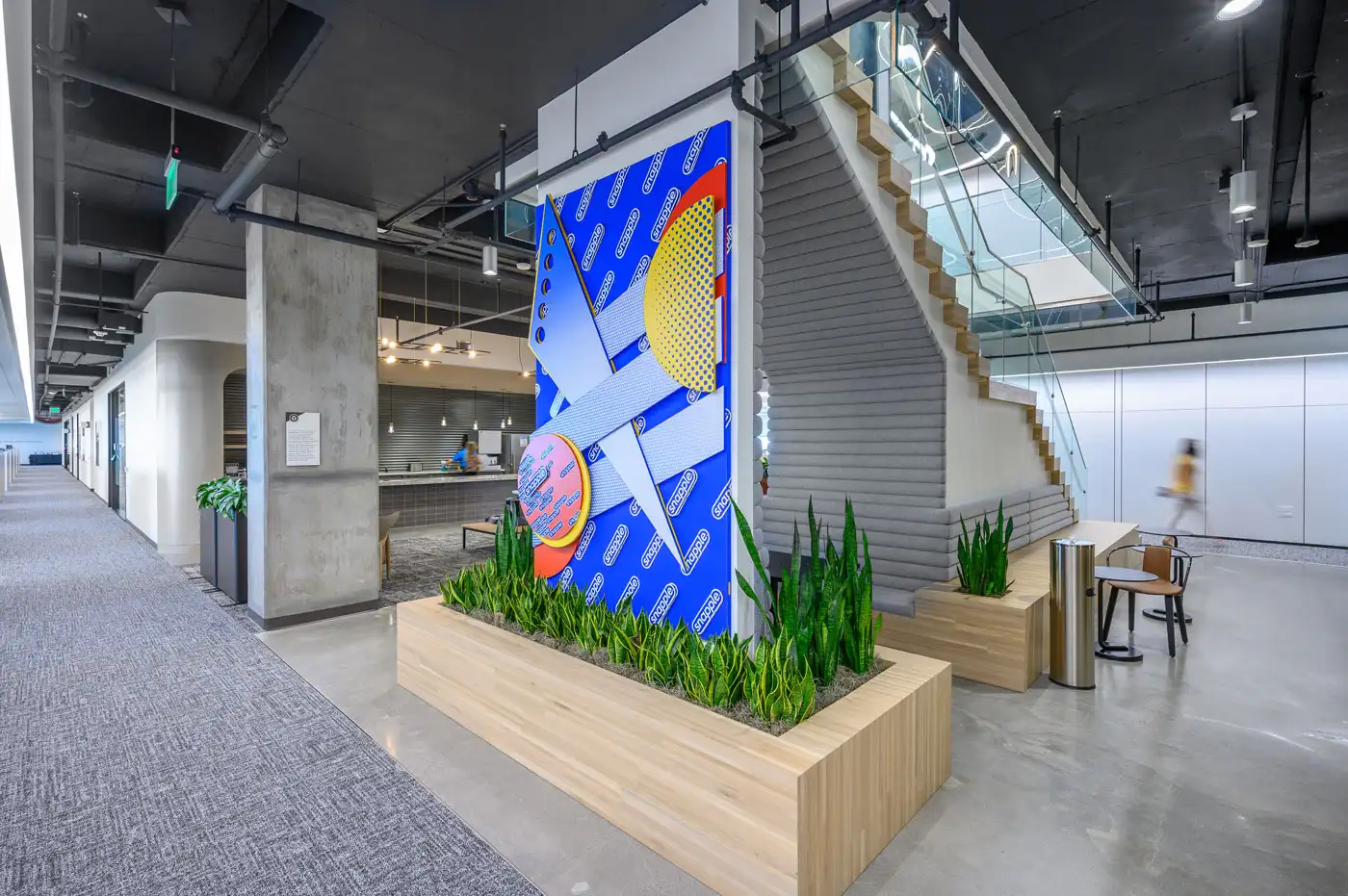Sourcing sustainable art can be an unexpected way for architecture and design firms to practice sustainability through interiors. Studies show that interior renovations could be responsible for the biggest embodied carbon footprint over a building’s lifetime. This makes it important for those charged with sourcing art to understand the impact cycle of every piece, a real challenge for busy designers. Fortunately, a knowledgeable art consultant can streamline this process for you.
Art consultants are also project managers, and that makes them experts at viewing art from a systems perspective. That’s the same perspective sustainability experts advise designers to use. It means not only looking at how a product is manufactured and how it will be used, but also where it will end up and what systems it will affect.
To approach art procurement from a systems perspective, art consultants consider art and framing materials, shipping, installation, storage and conservation. All of which affect the life expectancy of the piece. Approached in this way, the art you source can become a showcase of organizational values for both you and your clients. Read on to learn more about sourcing sustainable art and partnering with an art consultant to streamline the process.
Approaching Art Procurement from a Systems Perspective
When designing interiors for sustainability, it’s important to analyze the many systems that will be touched by the art you want to procure. Those include art and framing material extraction, art logistics and art conservation. Let’s briefly examine some of the opportunities they offer for sustainability measures to be put in place.
Using More Sustainable Art Materials
Art materials are what designers often think of when sourcing more sustainable art, and with good reason. Traditional art materials can be made with chemicals toxic to humans and the environment and they can be extracted in unsustainable ways. Pigments containing metals like cadmium, lead, and chromium are harmful to people, animals, soil and water if not handled and disposed of correctly. Many art supplies like paints, varnishes, solvents, glues, adhesives and permanent markers contain volatile organic compounds or VOCs. VOCs vaporize at room temperature, releasing off-gases during use or simply throughout the life of the artwork.
Fortunately, many artists and art supply companies are innovating more sustainable materials for art. And although there are hurdles to widespread adoption, they are nonetheless a tremendous step forward. Today, art professionals are rethinking every single ingredient that goes into their materials in order to produce work that aligns with their values. Let’s look at some examples.
Natural Pigments
Natural pigments made from plants, minerals and the earth are more widely available for artists to purchase today than in the past. Thinking more systemically, some artists are creating their own natural dyes. One artist in our database creates textile art with dye she makes using beans and radishes, a practice that happens to be part of her cultural heritage. In this way, the materials are not only more sustainable, but they also become elements for storytelling through representation.
Encaustic Painting
Encaustic painting is a practice going back to the ancient Greeks that’s seen a resurgence in the art world. It entails melting beeswax and crystalized tree resin and fusing them together, often with pigment, to create paintings. Not only are the materials organic, but the process makes the artwork highly durable. In fact, some encaustic paintings have lasted since the first century! Our clients at TIAA, commissioned an abstract, encaustic, mixed media series with layers of beeswax, paint, paper and wood.

TIAA commissioned this abstract, encaustic, mixed media series made with layers of beeswax, paint, paper and wood.
Recycled Art Materials
Some sculptors recycle materials to create new works. TIAA recently commissioned an artist who uses recycled metals to create 100% recyclable sculptures that look like giant origami pieces. Another artist was commissioned to make art installations out of old books.
Gallery: TIAA recently commissioned 100% recyclable sculptures made of partially recycled metal as well as art installations made with repurposed books.
Talavera Lofts wanted art that brings high design to mixed-income renters in East Austin. For the kids playroom, they commissioned a piece made of recycled candy wrappers. The local Austin artist used the wrappers and round wood cutouts to form installation pieces that call to mind hard candy. In a common area is a mixed-graphics aluminum can mosaic made from punched out discs.
Gallery: Talavera Lofts in East Austin commissioned an installation made of recycled candy wrappers for the kids playroom. In a common area, art made with repurposed aluminum discs becomes a moving mosaic that undulates as people pass.
Keurig Dr Pepper (KDP) wanted art for their new offices that highlights their deep commitment to sourcing, producing, and distributing beverages responsibly. They commissioned an artist who repurposed their product packaging into dynamic pop art installations. The art brings a wow factor to the space and offers an engaging way for employees to discuss KDP’s corporate responsibility goals with visitors.
Gallery: Art made with repurposed product packaging brings a wow factor to Keurig Dr Pepper’s new offices and creates an engaging way for employees to relay corporate responsibility goals to visitors.
The team at Kaizen Development had a vision for the art in their Class AA office tower, The Link at Uptown, in Dallas, Texas, to reflect the location of the building where three neighborhoods meet. They commissioned an installation made of thousands of rolled up local publications and inspired by the layout of the neighborhood.
Gallery: Developers of the Dallas Class AA office tower The Link at Uptown commissioned an installation made of repurposed local periodicals and inspired by the layout of the neighborhood.
Lowering Your Art Logistics Carbon Footprint
Rethinking the moving, storing and handling of art, what’s called art logistics, is a powerful way to lower a project’s carbon footprint. Traditionally, commissioned art is transported back and forth across great distances between the artist, the framer, and the installation company. Artists build large, wooden crates to keep art safe during transport. While wood is a natural, renewable resource, crates for commissioned art are often custom-built for a single journey and thrown away after one use. Today, art patrons, artists, vendors and art logistics companies are rethinking these practices.
Working with Local Artists & Vendors
When a client says sustainability is their top priority, we often recommend using local artists and vendors. This instantly removes many of the sustainability challenges found in traditional art logistics. The art doesn’t have to be shipped across the country for framing and no one has to travel to perform the installation. It also cuts down on shipping materials because local transport containers don’t need the same level of durability and weather protection as those built for a long journey. Commissioning locally doesn’t have to mean sacrificing on quality, either. If you partner with an experienced art consultant, they should have a vast database of vetted artists and vendors, including those in your local area.
Sourcing More Sustainable Framing
Framing is a crucial part of art display that is often overlooked by clients. In the context of sustainability, art consultants take into consideration the longevity of the framing materials. For example, a laminate frame might cost less than real wood, but if it’s made with less stable materials, it’s going to peel over time. Certain woods and metals are more sustainable than others, as well. Your art consultant can work with the framer to select more earth-friendly materials. For example, you can source a frame made of wood that comes from responsibly managed forests or one made with recycled metal.
Using More Sustainable Shipping & Installation Methods

Photo Courtesy of ArtDirect.
When you can’t utilize local artists and vendors, there are still sustainable practices you can employ for shipping and installation.
Art Transport Consolidation
One way the art industry combats the environmental impact of art transport is by consolidating shipments. Art consultants routinely leverage their network of art industry contacts to partner with galleries and art logistics vendors to this end. Not only does consolidating art shipments lower a project’s carbon footprint, but it also has the potential to lower shipping costs. The earlier you bring an art consultant onto your project, the better chance they have of finding a shipment that can accommodate your piece.
Reusing and Recycling Shipping Crates

Photo Courtesy of ArtDirect.
In the traditional art installation model, artists construct large wooden crates, often filled with unsustainable packing materials to safely ship their artwork to the installer. Once the art is unpacked on site, art installers usually throw away the crate as storing it would mean devoting costly real estate they don’t have. As sustainability has become a more mainstream goal, however, some art installers have begun to employ solutions to the shipping crate reuse issue. This can mean shipping the crate back to the artist, (preferably by ground transport), or if the artist is local, coordinating with the artist to pick up the crate. If neither of these are an option, some installers will reuse or recycle the crate. An experienced art consultant will know which art installation specialists in your area offer sustainable options.
Conclusion
Sourcing sustainable art is a fantastic way to showcase organizational values for both you and your clients. Whether you want to work with local artists and vendors, commission art made with sustainable materials, or rethink art logistics, partnering with an art consultant will streamline the entire process. As always, bringing an art consultant on board early in the project, ensures you have more sustainability options at your disposal.
Learn More About Sourcing Sustainable Art
- Systems Thinking in Art [lifestyle.sustainability-directory.com]
- Jeremy Faludi: Sustainability professor on why most sustainable design fails before it starts [Design Better Podcast]
- Why Interior Designers Must Fight Climate Change [Metropolis]
- Gallery Climate Coalition Best Practice Guidelines [GCC]


